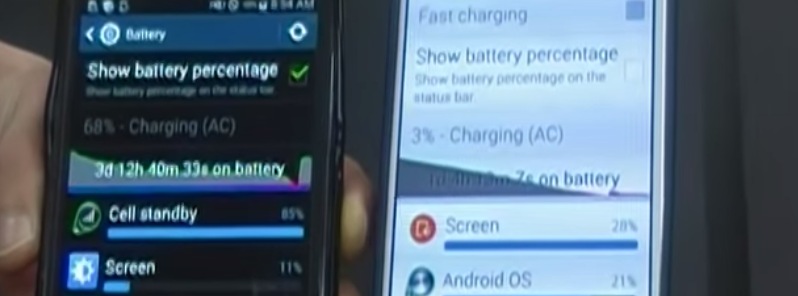Omnidirectional wireless charging technology for mobile devices developed

A new wireless power transfer (WPT) system developed by a group of researchers at The Korea Advanced Institute of Science and Technology (KAIST) is capable of charging multiple mobile devices concurrently and with unprecedented freedom in any direction, even while holding the devices in midair or a half meter away from the power source.
Mobile devices like smartphones, tablet pc's or laptops have become indispensable parts of our everyday life. Those days have gone when people used to stick to one single spot to do regular work. Various mobile devices have eliminated the need to stay in a single place to perform tasks. However, one challenge that manufacturers of these mobile devices still face is lower battery back up.
Using the new KAIST technology, mobile devices do not need to be connected to a charger or to be even close to the power source. In a way, it works just like WiFi does for the internet. As long as the mobile device users stay in a designated area where the charging is available, the Wi-Power Zone, the device will pick up power automatically as needed without any wire being used.
The research findings were published in the June 2015 on-line issue of IEEE Transactions on Power Electronics, which is entitled "Six Degrees of Freedom Mobile Inductive Power Transfer by Crossed Dipole Tx (Transmitter) and Rx (Receiver) Coils." Led by Professor Chun T. Rim of the Nuclear and Quantum Engineering Department at KAIST, the WPT technology that the research team developed allows multiple mobile devices to be charged concurrently and also irrespective of in which direction they are being held, whether in midair, or half a meter away from the power source (the transmitter).
The research team used the Dipole Coil Resonance System (DCRS) to induce magnetic fields. The DCRS is composed of two (transmitting and receiving) magnetic dipole coils, placed in parallel, with each coil having a ferrite core and connected with a resonant capacitor. The ferrite cores are optimally designed to reduce the core volume by half, and their ability to transfer power is nearly unaffected by human bodies or surrounding metal objects, making DCRS ideal to transmit wireless power in emergency situations. The DCRS was developed by the same team in 2014 for inductive power transfer over an extended distance.
The research team demonstrated their WPT technology on July 7, 2015 at a lab on KAIST's campus. They used high-frequency magnetic materials in a dipole coil structure to build a thin, flat transmitter (Tx) system shaped in a rectangle with a size of 1m2. Either 30 smartphones with a power capacity of one watt each or 5 laptops with 2.4 watts each can be simultaneously and wirelessly charged at a 50 cm distance from the transmitter with six degrees of freedom, regardless of the devices' three-axes positions and directions. The maximum power transfer efficiency for the laptops was 34%.

Demonstration of 30 Watts Range Omnidirectional Wireless-charging at a Laboratory on KAIST’s Campus, Video credit: KAIST Nuclear Power Electronics & Robotics Lab.
The research team rearranged the two dipole coils from a parallel position to cross them in order to generate rotating magnetic fields, which was embedded in the Tx's flat platform. This has made it possible for mobile devices to receive power from any direction. Until now, though wireless charging technologies existed, there has been the lack of freedom of direction in which the devices could be held or placed. Also, with this technology, no charging pad is needed.
The previous wireless technologies developed had difficulties of short charging distance, mostly less than 10 cm. The newly introduced WPT system has a great advantage over previous technologies in this context. Moreover, the DCRS works at a low magnetic field environment. Based on the magnetic flux shielding technology developed by the research team, the level of magnetic flux is below the safety level of the International Commission on Non-Ionizing Radiation Protection (ICNIRP) guideline (27uT) for general public exposure to electromagnetic field (EMF).
About the technology, Professor Rim says: "Our transmitter system is safe for humans and compatible with other electronic devices. We have solved three major issues of short charging distance, the dependence on charging directions, and plane coil structures of both Tx and Rx, which have blocked the commercialization of WPT."
At present, the research team and KAIST's spin-off company, TESLAS, Inc., have been conducting pilot projects to apply DCRS in various places such as cafes and offices.
Reference:
- "Six Degrees of Freedom Mobile Inductive Power Transfer by Crossed Dipole Tx and Rx Coils" – Choi, B.H.; Lee, E.S.; Sohn, Y.; Jang, G. – Power Electronics, IEEE Transactions on (Volume:PP , Issue: 99) – DOI: 10.1109/TPEL.2015.2449290
Featured image credit: KAIST.

Commenting rules and guidelines
We value the thoughts and opinions of our readers and welcome healthy discussions on our website. In order to maintain a respectful and positive community, we ask that all commenters follow these rules.